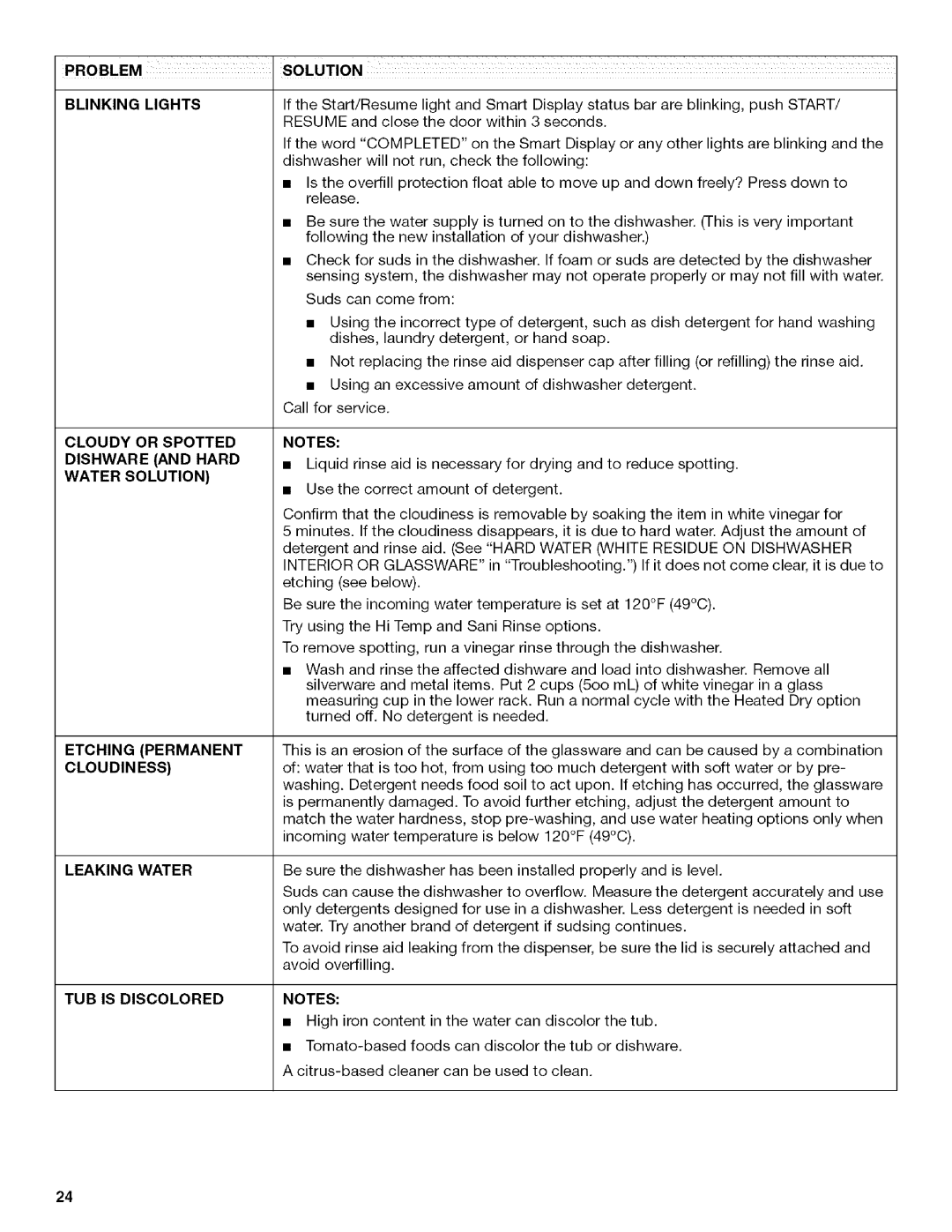
PROBLEM. SOLUTION
BLINKING LIGHTSIf the Start/Resume light and Smart Display status bar are blinking, push START/ RESUME and close the door within 3 seconds.
If the word "COMPLETED" on the Smart Display or any other lights are blinking and the dishwasher will not run, check the following:
•Is the overfill protection float able to move up and down freely? Press down to release.
•Be sure the water supply is turned on to the dishwasher. (This is very important following the new installation of your dishwasher.)
•Check for suds in the dishwasher. If foam or suds are detected by the dishwasher sensing system, the dishwasher may not operate properly or may not fill with water.
Suds can come from:
•Using the incorrect type of detergent, such as dish detergent for hand washing dishes, laundry detergent, or hand soap.
•Not replacing the rinse aid dispenser cap after filling (or refilling) the rinse aid.
•Using an excessive amount of dishwasher detergent.
|
| Call for service. |
| |
CLOUDY | OR SPOTTED | NOTES: |
| |
DISHWARE (AND HARD | • | Liquid rinse aid | is necessary for drying and to reduce spotting. | |
WATER | SOLUTION) | • | Use the correct | amount of detergent. |
|
| |||
Confirm that the cloudiness is removable by soaking the item in white vinegar for
5 minutes. If the cloudiness disappears, it is due to hard water. Adjust the amount of detergent and rinse aid. (See "HARD WATER (WHITE RESIDUE ON DISHWASHER INTERIOR OR GLASSWARE" in "Troubleshooting.") If it does not come clear, it is due to etching (see below).
Be sure the incoming water temperature is set at 120°F (49°C).
Try using the Hi Temp and Sani Rinse options.
To remove spotting, run a vinegar rinse through the dishwasher.
•Wash and rinse the affected dishware and load into dishwasher. Remove all
silverware and metal items. Put 2 cups (500 mL) of white vinegar in a glass measuring cup in the lower rack. Run a normal cycle with the Heated Dry option turned off. No detergent is needed.
ETCHING (PERMANENT | This is an erosion | of the surface of the glassware and can be caused by a combination | |
CLOUDINESS) | of: water that is too hot, from using too much detergent with soft water or by pre- | ||
| washing. Detergent needs food soil to act upon. If etching has occurred, the glassware | ||
| is permanently damaged. To avoid further etching, adjust the detergent amount to | ||
| match the water hardness, stop | ||
| incoming water temperature is below 120°F (49°C). | ||
LEAKING WATER | Be sure the dishwasher | has been installed properly and is level. | |
| Suds can cause the dishwasher to overflow. Measure the detergent accurately and use | ||
| only detergents designed for use in a dishwasher. Less detergent is needed in soft | ||
| water. Try another brand of detergent if sudsing continues. | ||
| To avoid rinse aid leaking from the dispenser, be sure the lid is securely attached and | ||
| avoid overfilling. |
|
|
TUB IS DISCOLORED | NOTES: |
|
|
| • High iron content in the water can discolor the tub. | ||
| • | foods | can discolor the tub or dishware. |
A
24
